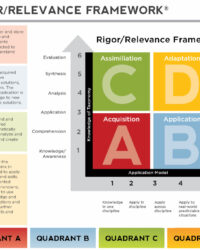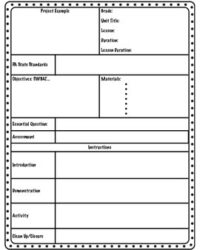Designing effective lessons can often feel like an art form, a delicate balance between conveying information and ensuring students truly grasp the material. In the bustling world of education, where technology rapidly reshapes the learning landscape, a structured approach becomes not just helpful, but essential. That’s where the ASSURE model steps in, offering educators a systematic and adaptable framework to plan and deliver engaging, technology-integrated lessons that truly resonate with learners.
The ASSURE model, an acronym standing for Analyze Learners, State Objectives, Select Methods, Media & Materials, Utilize Media & Materials, Require Learner Participation, and Evaluate & Revise, provides a clear roadmap for instructors. It’s a remarkably intuitive design process that guides you through every crucial step, ensuring that your teaching strategies align perfectly with your students’ needs and your learning goals. By meticulously following this sequence, educators can create dynamic and impactful learning experiences, moving beyond traditional lecture formats to truly foster active engagement.
Demystifying the ASSURE Model: A Step-by-Step Approach to Effective Instruction
The power of the ASSURE model lies in its logical progression, ensuring that no critical element of lesson design is overlooked. It begins with a deep understanding of your audience and culminates in a reflective evaluation of the lesson’s success, providing a comprehensive cycle for continuous improvement. This systematic approach is particularly beneficial for integrating new technologies or innovative teaching methods into the classroom, as it forces a thoughtful consideration of how these tools will serve the instructional goals and benefit the learners.
Each phase of the ASSURE model builds upon the last, ensuring a cohesive and well-rounded lesson plan. From understanding the nuances of your students’ backgrounds to selecting the perfect interactive software, every decision is rooted in a pedagogical purpose. This meticulous planning not only enhances the learning experience for students but also instills confidence in the instructor, knowing that they have prepared a lesson that is both comprehensive and considerate of their learners’ needs.
Analyzing Your Learners for Optimal Engagement
The initial “Analyze Learners” step is foundational. Before you even think about content, you need to understand who you’re teaching. This involves gathering information about their general characteristics such as age, grade level, and cultural background, but also more specific details like their prior knowledge of the subject, preferred learning styles (visual, auditory, kinesthetic), and any special needs or interests they might have. A thorough analysis ensures that the subsequent lesson components are tailored to be most effective and engaging for *your* specific group of students.
Crafting Clear Objectives and Selecting the Right Tools
Once you know your audience, the next crucial steps are “State Objectives” and “Select Methods, Media, & Materials.” Stating objectives involves clearly defining what students should be able to do or know by the end of the lesson. These objectives should be SMART: Specific, Measurable, Achievable, Relevant, and Time-bound. After setting clear targets, you move to selecting the instructional strategies, media, and materials that will best help students achieve those objectives. This might involve choosing between lectures, group activities, simulations, or project-based learning, along with selecting specific tools like videos, textbooks, interactive whiteboards, or online resources. The beauty of the ASSURE model is its emphasis on purposeful selection.
The final steps – Utilize Media & Materials, Require Learner Participation, and Evaluate & Revise – complete the cycle. Utilizing involves putting your selected methods and materials into practice effectively. Requiring learner participation ensures that students are actively engaged, not just passively receiving information. Finally, evaluation is critical; it’s where you assess if the objectives were met and reflect on what worked well and what could be improved for future lessons.
Here is a summary of the steps in the ASSURE Model:
- Analyze Learners
- State Objectives
- Select Methods, Media, and Materials
- Utilize Media and Materials
- Require Learner Participation
- Evaluate and Revise
Why Every Educator Should Consider an ASSURE Model Lesson Plan Template
Embracing an assure model lesson plan template offers a multitude of benefits that extend beyond simply organizing lesson content. It inherently promotes a learner-centered approach, shifting the focus from what the teacher will teach to what the students will learn and how they will learn it. This emphasis on the learner ensures that lessons are not only comprehensive but also highly relevant and engaging, catering to diverse learning styles and needs. It’s a proactive framework that anticipates potential challenges and provides strategies to overcome them, leading to smoother lesson delivery and more effective learning outcomes.
Furthermore, the ASSURE model is particularly powerful for integrating technology seamlessly into the curriculum. Unlike models that might view technology as an add-on, ASSURE encourages educators to consider media and materials, including digital tools, from the very beginning of the planning process. This ensures that technology is used purposefully to enhance learning, rather than just for the sake of using it, making lessons more interactive and contemporary. It empowers teachers to explore and utilize a vast array of resources, from educational apps to virtual reality simulations, all within a structured pedagogical framework.
The reflective nature of the “Evaluate & Revise” step is invaluable for professional growth. It encourages educators to constantly assess their teaching strategies, analyze student performance, and make necessary adjustments. This iterative process of planning, implementing, and evaluating fosters continuous improvement, transforming good teachers into great ones. The structure provided by an assure model lesson plan template helps identify areas of strength and areas needing refinement, making every lesson a learning experience for both students and instructors.
Some key advantages of using the ASSURE Model include:
- Fosters Learner-Centered Design
- Streamlines Technology Integration
- Ensures Comprehensive Planning
- Supports Effective Evaluation
- Boosts Instructor Confidence
Ultimately, adopting the ASSURE model as your guiding principle for lesson design can profoundly transform your teaching practice. It moves you from merely presenting information to orchestrating rich, interactive learning environments where every student has the opportunity to succeed. By meticulously planning each phase of instruction and considering the unique needs of your learners, you build a robust foundation for truly impactful educational experiences.
This systematic yet flexible approach empowers educators to deliver lessons that are not only well-organized but also deeply engaging and responsive to the evolving demands of modern education. It’s a framework that supports continuous improvement, fostering a cycle of effective instruction that benefits both teachers and students, ensuring that every learning moment is maximized for growth and understanding.


